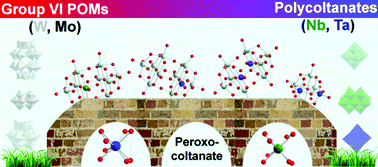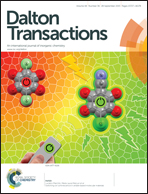Bridging the opposite chemistries of tantalum and tungsten polyoxometalates†
Abstract
The disparate solubility, redox activity, and pH stability of the group V and group VI polyoxometalates (POMs) confer very different functionality on these species, and tailoring cluster properties by varying the ratio of group V to group VI metals poses both an opportunity and a synthetic challenge. A classic series of studies reported over 40 years ago provided some insight into W/Nb POMs, from which researchers have built on to date. However, the analogous W/Ta series has never been addressed in a systematic manner. Three members of this W/Ta series are presented here, synthesized from simple oxo- and peroxocoltanate precursors. [Ta3W3O19]5− displays the Lindqvist-type structure, while [TaW9O32]5− and [Ta2W8O32]6− are isostructural with decatungstate ([W10O32]4−). Additionally, the use of peroxoniobate instead of hexaniobate as the starting material drives the formation of the decatungstate-type structure [NbW9O32]5− instead of the Lindqvist ion that was established to be the foundational cluster geometry in prior work. The electronic structure of the Nb/Ta substituted decatungstates is directly related to the degree of substitution inasmuch as the HOMO–LUMO energy gap (Egap) slightly increases as more Nb/Ta atoms are incorporated into the structure. The poor mixing of the d-orbitals of Nb/Ta and W is responsible for the observed trends in the UV spectra and cyclic voltammetry. Moreover, the stability of the molecular frameworks in the gas phase is also related to the extent of substitution as revealed by electrospray mass-spectrometry (ESI-MS).


 Please wait while we load your content...
Please wait while we load your content...